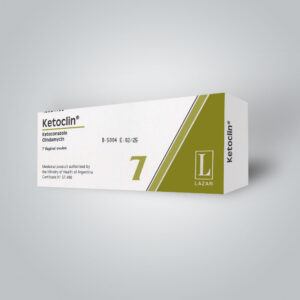 KETOCLIN vaginal suppositories
KETOCLIN vaginal suppositories
KETOCLIN®
Composition
Active ingredients: 1 tablet contains 2.17 g of potassium citrate, 2.0 g of potassium bicarbonate, 2.057 g of anhydrous citric acid.
Excipients: sucrose and glucose syrup, macrogol 6000, saccharin, lemon flavoring D-Sorbitol..
Description
They are white, opaque, oval-shaped suppositories.
Pharmacotherapeutic group:
Geniş spekrli antibakterial, antifunqal təsirə malik vaginal suppositories.
ATC kodu: Clindamycin: G01AA10; Ketoconazole:D01AC08.
Pharmacological characteristics:
Clindamycin is an antibacterial substance from the lincosamide group with a wide spectrum of action. Clindamycin has an inhibitory effect on protein synthesis in bacteria by affecting the ribosome of bacteria. It mainly binds to the 50S subunit of the ribosomal membrane, inhibits protein synthesis and affects the process of building a peptide chain. Clindamycin has a wide spectrum of action, has a bacteriostatic effect in therapeutic doses, and has a bactericidal effect on microorganisms in high doses. Clindamycin is active mostly against gram-positive aerobic, as well as gram-positive and gram-negative anaerobic bacteria. Gardnerella vaginalis, Mobiluncus spp. It is active against microorganisms associated with bacterial vaginosis (in vitro). Mobiluncus mulieris, Mobiluncus curtisii, Mycoplasma hominis and Peptostreptococcus spp., Bacteroides spp. Gardnerella vaginalis.
Ketoconazole is an imidazoledioxolane derivative, has antifungal, fungicidal, anti-inflammatory, fungistatic, antiandrogen properties, has a targeted effect on the pathological center. The use of vaginal tablets allows to destroy the pathogenic flora that causes burning and itching of the vagina in the shortest possible time, and to get rid of unpleasant symptoms. The mechanism of action is based on inhibiting the synthesis of ergosterol and changing the lipid content of the mushroom membrane. (Candida, Trichophyton, Epidermophyton, Entomophthorales, Pityrosporum, Torulopsis, Cryptococcus, Malassezia furfur) has mainly a fungicidal effect against Candida albicans. Even gram-positive cocci: Staphylococcus spp., Streptococcus spp. is active against.
Pharmacokinetics
Clindamycin – has a low absorption rate during vaginal use; the concentration in the blood is about 2% to 8%. Absorption when applied on the skin is very low (0-3 ng / ml). Clindamycin administered vaginally is not metabolized through auto-depuration and is eliminated from the body with normal secretions.
Ketoconazole – absorption into the blood during vaginal use is minimal. The maximum concentration in plasma can be 20.7 ng / ml. Ketoconazole, when used vaginally, does not undergo biotransformation and is eliminated through the mechanism of vaginal autodeflection.
Instructions for use:
- Bacterial vaginosis caused by Gardnerella vaginalis, Mobiluncus spp
- Vaginosis and vaginal candidiasis caused by other anaerobic bacteria such as Bacteroides fragilis.
- Vaginal infections resistant to other antiprotozoa.
- In the treatment of aerobic and anaerobic mixed vaginal infections.
Contraindications
Hypersensitivity to any component contained in the preparation. It is contraindicated in patients suffering from Crohn’s disease, ulcerative colitis, and colitis caused by the use of antibacterial drugs.
Interactions with other drugs
Enhances the effect of aminoglycosides and rifampicin. Strengthens the myorelaxant effect of N-cholinoblockers.
Use during pregnancy and lactation
It is not recommended to use in the 1st trimester of pregnancy, but it can be used in other trimesters under the supervision of a doctor. There are no restrictions on the use of the drug during lactation. Thus, absorption into the blood during local use is minimal and has no toxic effect. During the in vitro studies of Ketoconazole and Clindamycin, it was found that the drug does not have a mutagenic effect.
İstifadəsi qaydası və dozalanma qaydası
1 suppositories is used 1 time before going to bed at night
Side effects
In patients with a sensitive body, the drug can cause dryness of the vaginal mucus, irritation and itching in the external genitalia. These cases also occur when the use of the drug is stopped. Genital canal: symptomatic cervicitis (16%), Candida albicans (11%), vaginal trichomonads (1%), vulva irritation (6%). On the skin – rash, redness. Gastrointestinal system: heartburn, nausea, vomiting, diarrhea, constipation. Abdominal pains. Side effects that may arise after the use of clindamycin include pseudomembranous colitis, contact dermatitis, erythema and skin irritation, and folliculitis caused by gram-negative bacteria.
Packing form
7 suppositories, in contoured-slot packaging. 1 contour-slot packaging, packed in a cardboard box with an insert.
Store condition
It should be stored at a temperature of 15-30 °C, in a dry, cool place and out of the reach of children.
By prescription
Manufacturer
Dr. Lazar & Cía S.A.Q: e I.
Av. Vélez Sársfield 5855. Munro-B1605EPI, Argentina.
